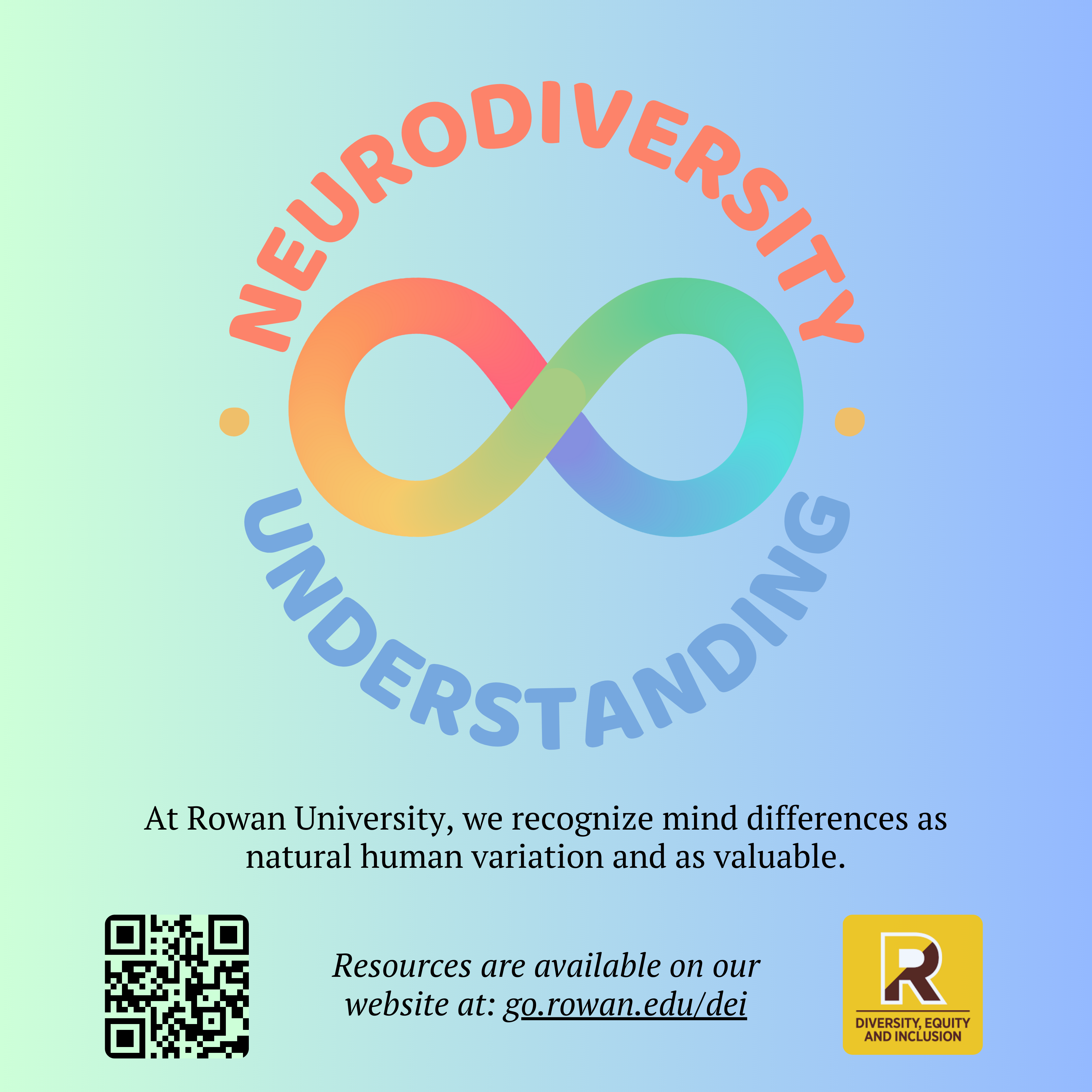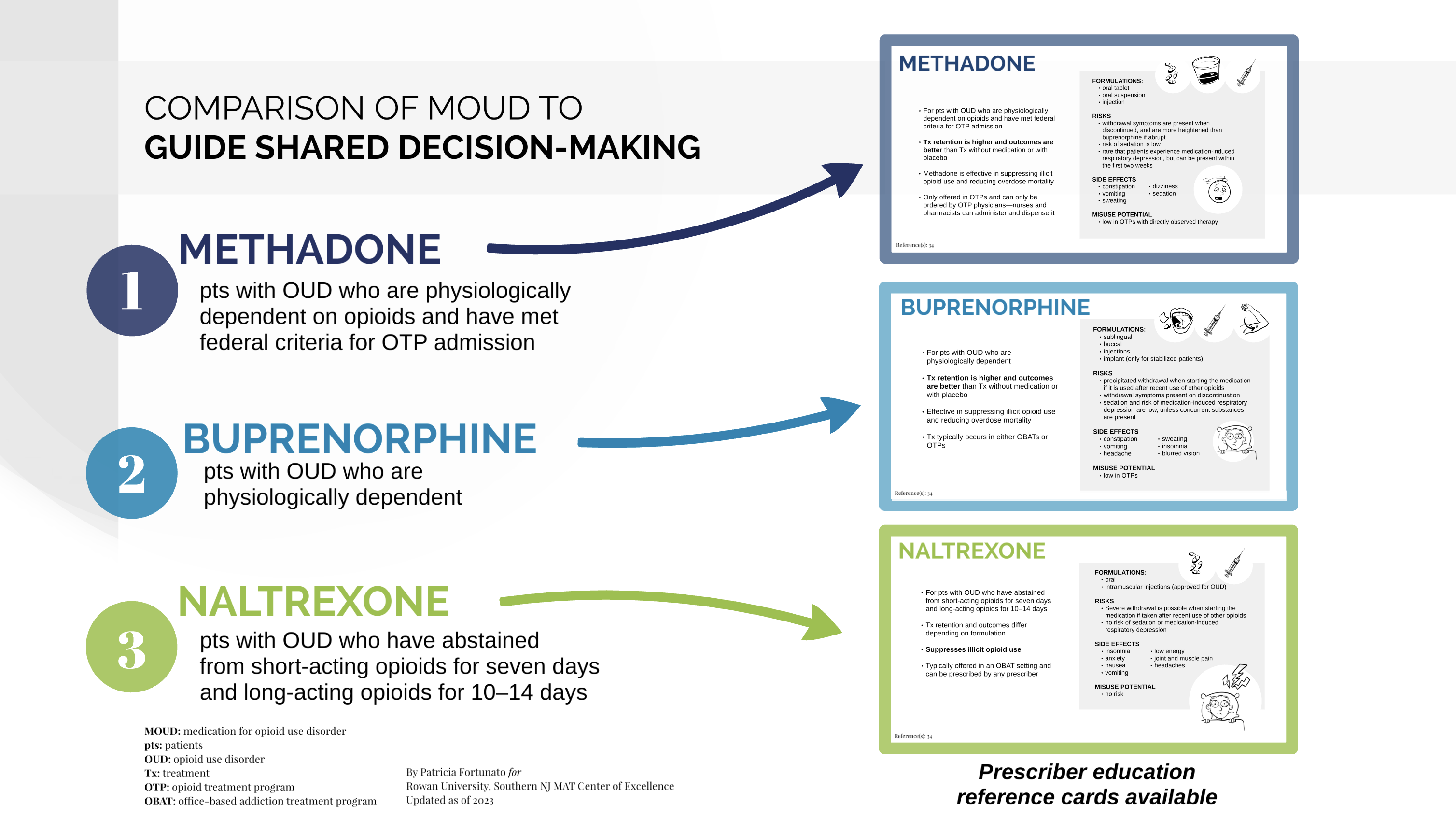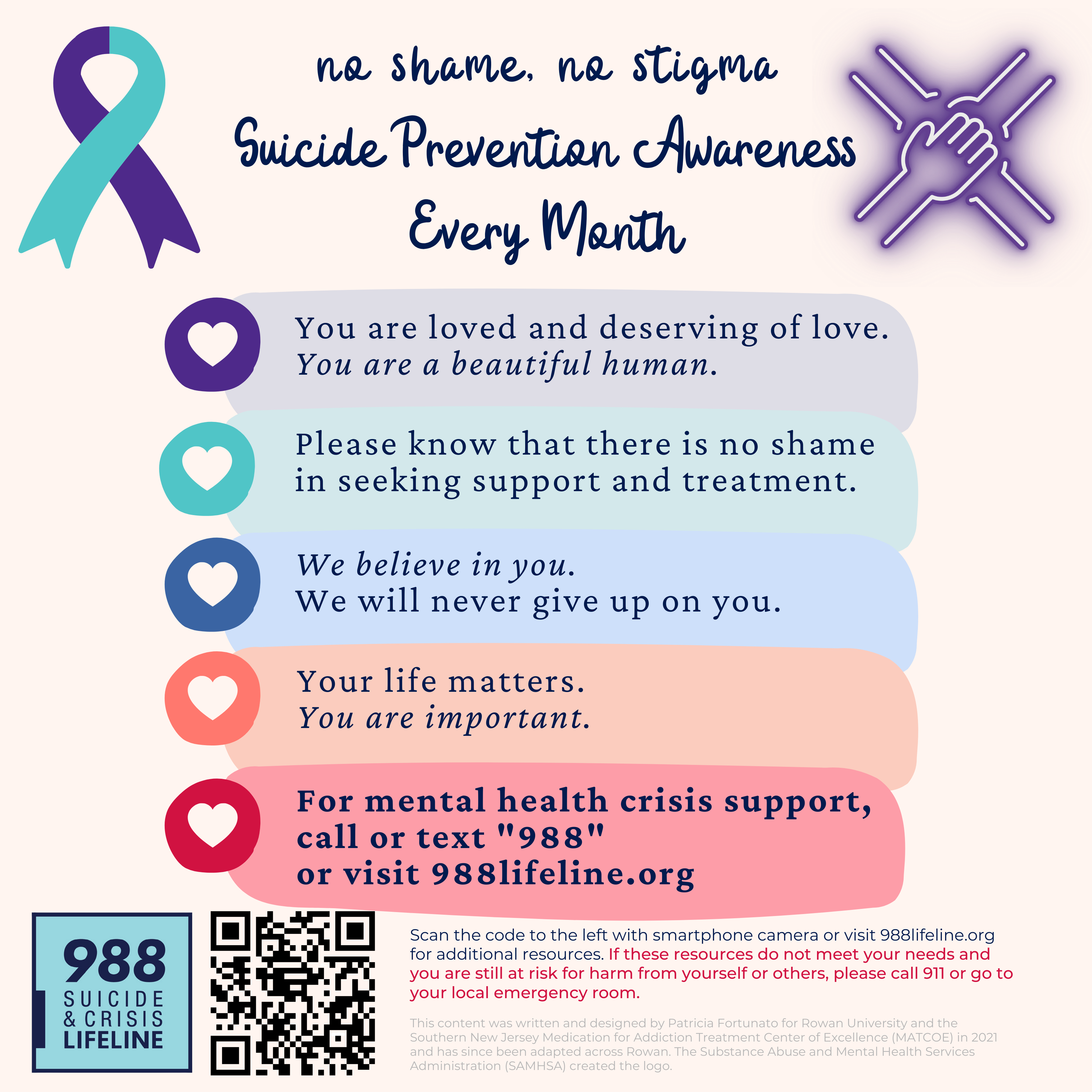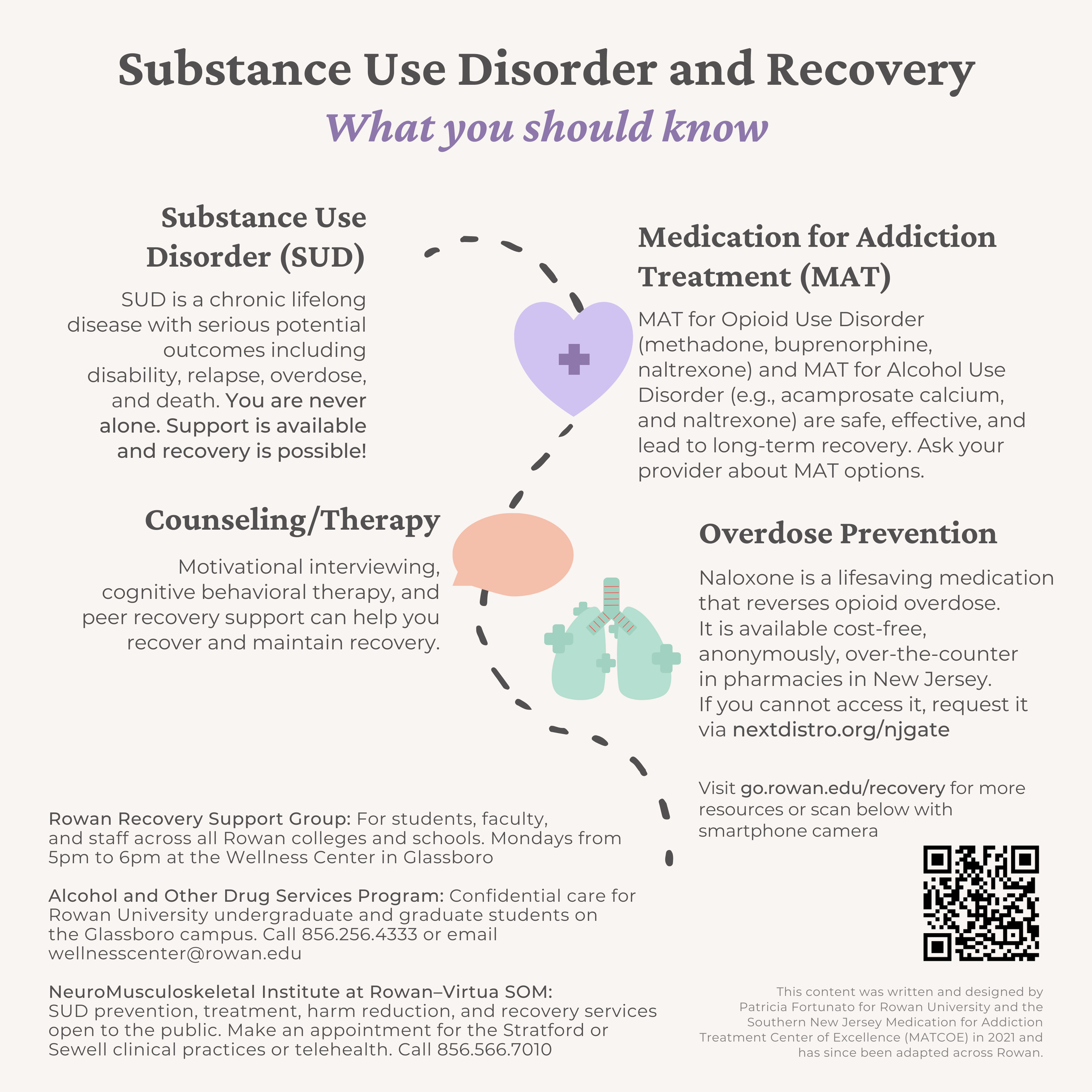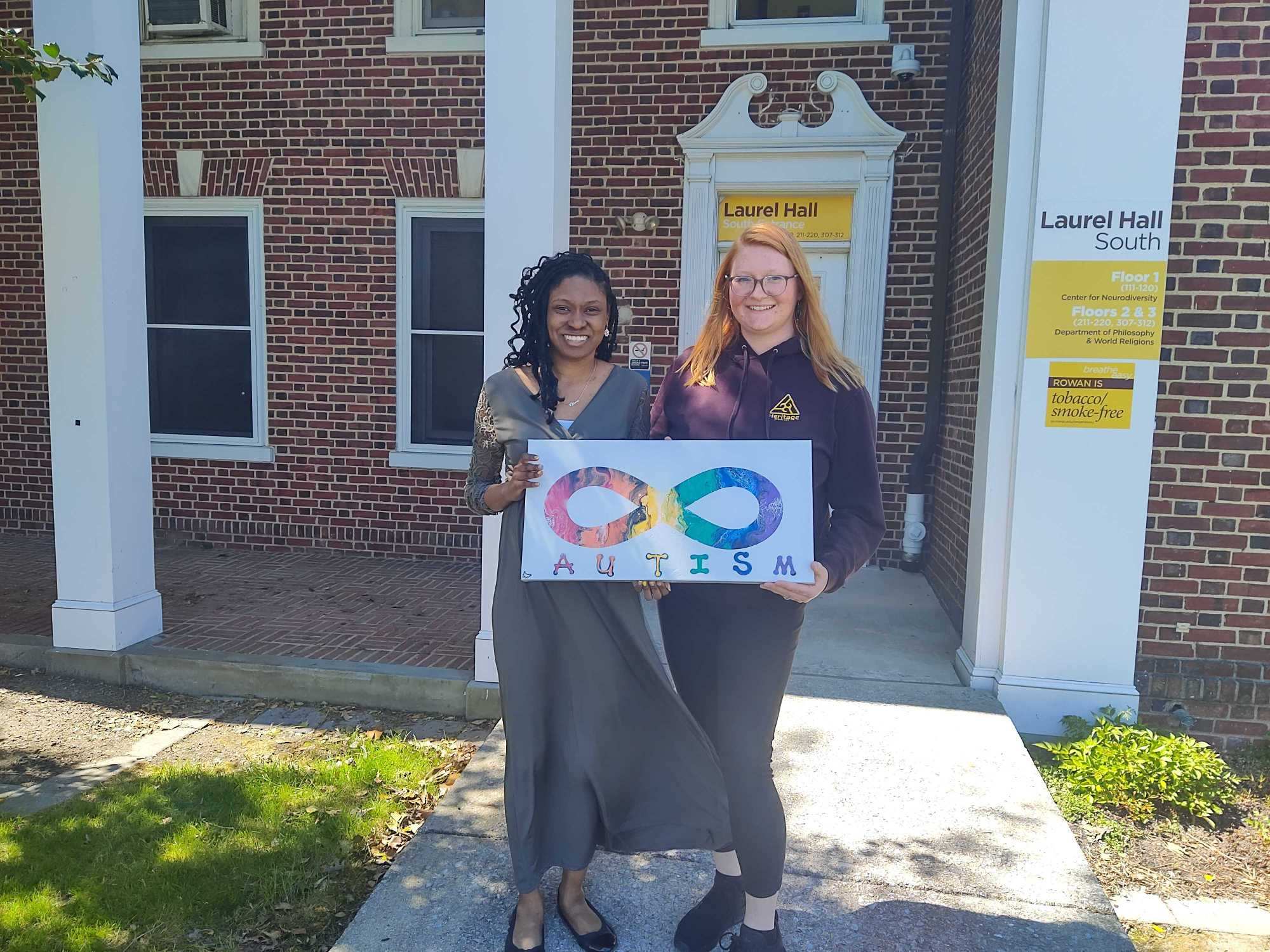
Image Alternative Text: Depicted left to right are Chiara Latimer and Amanda Bonnino of the Center for Neurodiversity, holding artwork by Kenny Davis, an openly autistic artist who also openly identifies as in long-term recovery. The artwork features a rainbow infinity symbol in red, orange, yellow, green, blue, and purple, against a white background, with the word "autism" in corresponding shades below the symbol. Latimer and Bonnino are standing in front of Laurel Hall at Rowan University, where the Center for Neurodiversity is facilitated.
This article was written by Patricia Fortunato (fortun83@rowan.edu) as part of the Rowan University Division of Diversity, Equity, and Inclusion (DEI) team. Previously, she served as instructional designer and content/program manager for pain and addiction medicine clinical research affiliated with the osteopathic and allopathic medical schools, wherein she worked to foster neurodiversity understanding among prescriber education and health communication.
With gratitude to all fellow neurodivergent staff, academic faculty, and students; allies who support our neurodivergent communities; and the Division of DEI team and DEI Council. Thank you all for helping to foster an inclusive Rowan University community.
For more than a decade, the Autistic Self-Advocacy Network (ASAN) has designated the month of April as Autism Acceptance Month.1 Throughout this spring and year-round, our Rowan University Division of Diversity, Equity, and Inclusion (DEI) works to raise awareness to promote autism acceptance; proliferation of neurodiversity understanding among our entire University community; and advancement of inclusion and belonging among neurodivergent communities. Please join us in sharing information and resources as we honor the unique, personal, lived experiences of neurodivergent individuals.
Save the Date: On Thursday, May 2, 2024, at 6pm, the Center for Neurodiversity, a center that is part of the Division of DEI, will offer a special "Neurodiversity and Advocacy in Education" virtual event. Bridgette Hamstead, founding director of Fish in a Tree, a community center serving the neurodivergent population in New Orleans, will share her lived experiences, challenges of navigating a neurotypical-centric world, and resilience of the neurodivergent community.
- Date and Time: Thursday, May 2, 2024, at 6pm
- Zoom Meeting Link: go.rowan.edu/neurodiversity050224
- Meeting ID: 883 0290 0418
- Passcode: 090313
Follow the Rowan University Division of DEI:
- Instagram: instagram.com/rowandei
- Facebook: facebook.com/rowandei
- X/Twitter: twitter.com/rowandei
- Threads: threads.net/@rowandei
Brief History of the Neurodiversity Movement
Neurodiversity is the full range of variations in cognition, learning, behavior, and socialization that exists within the entire general population. Individuals who identify as neurodivergent may include those who have "a mind that functions in ways which diverge significantly from the dominant societal standards of 'normal.'"2
The neurodiversity movement is a social justice movement based on the philosophy that mind differences are natural human variation, and should be embraced, celebrated, and valued. The term was conceived by autistic self-advocate and scholar, Judy Singer, in the late 1990s.3 Singer recognized that those with developmental, intellectual, psychiatric, and/or learning dis/abilities, now recognized as neurodivergent, were marginalized in society. As such, the neurodiversity movement recognizes that neuro differences are a socially-constructed category, similar to gender, sexuality, and/or dis/ability* status, etc.
Neurodiversity advocates acknowledge the lived experiences of neurodivergent individuals as they navigate a society that is not designed with their ways of being at the center, and therefore, advocates promote education and social support systems, inclusive programming, and accommodations. Some examples include communication and assistive technologies, occupational training, and independent living support. The movement emphasizes the goal of embracing neurodiversity and providing intentional support so that individuals can fully participate in society.
*The term dis/ability, (spelled with the slash)4 is used intentionally to illustrate how ability and disability are fluid rather than a static identity; individuals may exhibit both ability and disability in relation to different social environments. The use of the term disability (spelled without the slash) may suggest that an individual is represented or identified by what they cannot do, rather than what they can do.
Terms and Guidance for Inclusive Communications
- Ableism: Ableism is discrimination or prejudice, whether intentional or unintentional, against persons with disabilities.
- Accommodation: An accommodation is a modification, whether for classroom and/or workplace settings, that ensures an individual with a disability can complete required tasks and functions.
- Accessible: Accessible spaces and programs are made to be inclusive, and generally do not require accommodations. Accessibility is not only in response to disability.
- Americans with Disabilities Act (ADA): The ADA is a federal civil rights law designed to ensure that individuals with disabilities are fully included in society and protected from discrimination.5
- Identity First Language (IFL): IFL, such as the term "disabled person," emphasizes the disability as an identity. IFL stems from a countermovement in response to person-first language used by some disabled individuals who recognize their disability as part of who they are, not something from which to distance themselves. Some disabled individuals prefer IFL.
- Non-Apparent Disability: Non-apparent disabilities are those that are not immediately apparent. They can be physical, mental, and/or neurological conditions that limit an individual's daily functions. They are also sometimes referred to as hidden disabilities.
- Mobility Aid: Mobility aids are devices that assist an individual with movement. They can include mouth guards, braces, canes, crutches, walkers, wheelchairs, and/or other similar devices.
- Neurodivergent: Neurodivergent refers to an individual with a brain/mind that functions and processes information differently than dominant society's established norms.
- Neurodiverse: Neurodiverse refers to a group of both neurodivergent and neurotypical individuals; group diversity.
- Neurodiversity: Neurodiversity is the full range of variations in cognition, learning, behavior, and socialization that exists within the population.3 Individuals with the following identities may represent the neurodivergent community: attention deficit hyperactivity conditions, autism, dyscalculia, dyslexia, dyspraxia, and Tourette syndrome.
- Neuroqueer: Neuroqueer is a term with fluid meaning and is typically used as an identity or as an action to challenge both neurocognitive and gendered societal norms.
- Neurotypical: Neurotypical is a term used to refer to an individual with a brain/mind that functions in alignment with socially established norms.
- Section 504, Rehabilitation Act of 1973: Section 504 of the Rehabilitation Act of 1973 was and remains the first civil rights law that prohibits discrimination on the basis of disability.6
- Individuals with Disabilities Education Act (IDEA): IDEA was enacted by the United States Congress in 1975, requiring all public education institutions who receive federal funding to ensure equal access to education and one cost-free meal per day for children and adolescents with physical and mental disabilities. Today, this law continues to make available cost-free public education to eligible children and adolescents with disabilities throughout the U.S. and ensures access to inclusive education and services for these students. IDEA also governs how state and public agencies ensure early intervention, inclusive education, and related services for eligible infants, toddlers, children, and adolescents with disabilities. Further, the law authorizes both formula and discretionary grant funding.7
- In 2004, Congress reauthorized IDEA and in 2015, amended the law via Public Law 114–95 (Every Student Succeeds Act, ESSA), stating: "Disability is a natural part of the human experience and in no way diminishes the right of individuals to participate in or contribute to society. Improving educational results for children with disabilities is an essential element of our national policy of ensuring equality of opportunity, full participation, independent living, and economic self-sufficiency for individuals with disabilities."8
- Americans with Disabilities Act (ADA) of 1990: The ADA was enacted by Congress in 1990, prohibiting discrimination against individuals with disabilities in every area of public life, spanning education, employment, transportation, and overall, all public and private spaces open to the general public. This civil rights law works to ensure all individuals with disabilities have the same rights and opportunities as individuals without disabilities.5
- Americans with Disabilities Amendment Act (ADAAA) of 2008: The ADAAA was enacted by Congress on September 25, 2008, emphasizing that disability "should be construed in favor of broad coverage of individuals to the maximum extent permitted by the terms of the ADA and generally shall not require extensive analysis."9 These variances and changes support a simpler process for individuals seeking ADA protection to establish they have a disability(ies) within the definition.
- United Nations Convention on the Rights of Persons with Disabilities (UN CRPD): During the 56th session of the UN General Assembly in 2001, as a response to a proposal by President Fox of Mexico and based on experiences in social development and human rights, the General Assembly formed the ad hoc committee for "considering proposals for an international convention to uphold the dignity and rights of persons with disabilities."10
- Further, the Convention on the Rights of Persons with Disabilities and its Optional Protocol (A/RES/61/106) was adopted in 2006 and opened for signature in 2007.11 This was the first comprehensive human rights treaty of the 21st century, and the first human rights convention to open to signature by regional organizations. The Convention enacted the treaty in 2008—a benchmark document working to ensure enjoyment of human rights and freedoms by individuals with disabilities. Alongside other international human rights and development guidelines, a cohesive international framework was established to inform national policy making processes and legislation in order to develop an inclusive society and foster disability-inclusive development. On an international level, this framework promotes and supports disability-inclusive policy and practice; on a national level, it requires legislation and policy aligned with international standards.
- The CPRD continues to inform UN Member States in development and enactment of legislation and policy that works to ensure equity, inclusion, and overall empowerment of individuals with disabilities in society. The UN, its Member States, and other stakeholders continue to work towards mainstreaming the human rights, and perspectives and lived experiences, of individuals with disabilities in development frameworks across international, regional, national, and local/community-based levels. Mainstreaming and inclusion of individuals with disabilities is recognized as an effective strategy and featured in international development frameworks, including the UN 2030 Agenda for Sustainable Development.12
Celebrate Neurodiversity and Center Lived Experiences
"Nothing about us without us" is a phrase that proliferated in the English language as part of disability-related advocacy in the 1990s. Neurodiversity advocates have been critical of the ways in which policy and decision-makers have invisibilized neurodivergent individuals and individuals with disabilities from discussions that impact their lived experiences.13 For example, organizations such as Autism Speaks have received criticism concerning the lack of representation of autistic leadership and fundraising techniques that perpetuate stigma.14 When seeking to advance neurodiversity equity and inclusion, policymakers, educators, faculty, and staff must center neurodivergent and disabled identities within decision-making and social justice initiatives, as they are the experts of their lived experiences.
Throughout history and social contexts, neurodiversity has been viewed from a deficit perspective, with the inaccurate and harmful connotation that neurodivergent individuals are less than neurotypical individuals.16 Deficit-focused paradigms and perspectives perpetuate harmful stereotypes and assumptions concerning the populations, regarding individuals in terms of their perceived deficiencies and limitations.17 Rooted in deficit paradigms is the medical model,18 which views neurological differences as a medical condition to be "fixed." For example, the medical model utilizes stigmatizing and harmful labels such as "high-functioning autism" and "low-functioning autism."18 Neurodiversity is rooted in the social model, which shifts the focus to address systemic barriers that historically have resulted in inequitable opportunities and outcomes.19
The rainbow infinity symbol is often used to denote neurodiversity and autism. Of note, self-advocates tend not to embrace the puzzle piece symbol, which has a negative connotation to discriminatory history.15
Image Alternative Text: Depicted is a rainbow infinity symbol in soft shades of yellow, orange, red, green, and blue, against a gradient background in soft shades of green and blue. The text surrounding the symbol reads, "Neurodiversity Understanding" and below the symbol reads, "At Rowan University, we recognize mind differences as natural human variation and as valuable." The Rowan University Division of Diversity, Equity, and Inclusion (DEI) logo and website link to "go.rowan.edu/dei" are positioned at the bottom of the graphic.
Click here to download the graphic.
Support Neurodiversity at Rowan University
Support neurodiversity in the University environment. The neurodiversity paradigm is the perspective that there are diverse learners and professionals with neurological differences, all of whom should be recognized, embraced, and celebrated. The neurodiversity paradigm also seeks to advance accessibility, choices, resources, and inclusion. For example, educational and professional environments may hinder inclusion for neurodivergent individuals, such as spaces that do not account for sensory processing differences, or experiences with deficit perspectives and attitudes from educators, colleagues, and/or other students. Therefore, it is imperative for all environments to promote inclusion.
Universal Design for Learning and Instructional Design
An example of fostering more inclusive environments is through the principles of Universal Design for Learning (UDL) applied to instructional design and educational training content.20 UDL is a research-based teaching and learning approach that uses diverse methods to remove barriers to learning and provide all students with opportunities to succeed. UDL offers creativity, flexibility, and inclusion to cultivate strengths and needs.
Examples of UDL include and are not limited to image descriptions, closed captions, and assistive technologies as part of instructional design. The approach provides numerous formats to share information, including the following:
- virtual didactic, virtual asynchronous, and hybrid models
- audio, video, and other forms of multimedia
- algorithms, graphics, and other textual and visual media
- course outlines, supplemental handouts, and other ancillary materials
- formats for testing, including oral presentations and creative projects
Academic faculty, administrators, and staff should all study and utilize UDL to create contexts that honor and support the range of neurodivergent needs on campus. This process can also benefit neurotypical students. Learn more about DEI in teaching at the Faculty Center for Excellence in Teaching and Learning, a center jointly facilitated by the Division of DEI and Division of Academic Affairs.
Depicted below is an example slide and ancillary handouts excerpted from an instructional design package developed for academic medicine curricula. UDL principles, as a guiding ethos, were utilized in research and development of the curricula for both providers caring for special populations with pain and substance use disorder (SUD)/addictions, and patients and communities served, with sensitivity to potential learning needs of providers, patients, and families/loved ones. In the context of medicine, research indicates increased risk of SUD/addictions in neurodivergent individuals, with special focus on those with the following identities: autism21–26 and/or attention deficit hyperactivity conditions.27–31
Image Alternative Text: Depicted is an example slide from a physician education training series. The text reads, "Comparison of MOUD to Guide Shared Decision-Making," followed by methadone, buprenorphine, and naltrexone medication for opioid use disorder (MOUD) clinical referral guidelines. The descriptions are connected to arrows in corresponding shades of blue and green, linking to ancillary prescriber education reference cards further expounding upon descriptions, clinical scenarios, formulations, and effects of each MOUD, along with corresponding graphics. The curricula is part of Rowan University.
Click here to enlarge the example slide.
Rowan University Community of Support
Support for Rowan University Students:The Office of Accessibility Services at Rowan University: This campus office, located in Glassboro, provides accommodations and assistance to undergraduate and graduate students with documented disabilities in accordance with Section 504 of the Rehabilitation Act of 1973 and the ADA of 1990. Students who meet University admissions requirements (i.e., otherwise qualified to attend the University) are required to submit appropriate documentation so that the University can determine whether they qualify for reasonable accommodations. Learn more about these services on the Rowan University website at this link, and contact the Office of Accessibility Services at successcenter@rowan.edu or call 856-256-4259.
Other services provided by this office include and are not limited to the following:
Sensory-Friendly Spaces at Rowan University: There are designated sensory-friendly spaces on the Glassboro campus which allow Rowan undergraduate and graduate students to have access to a place for decompression. Each space has low lighting, limited sound options, and access to fidgets. These spaces are located in Hawthorne Hall 202 near the front desk for SJICR; Laurel Hall 116 in the Center for Neurodiversity; and Discovery Hall's Quiet Room on the first floor.
Neurodiversity Club for Rowan University Students: This student-run organization strives "to help neurodivergent students become better self-advocates equipped to thrive in college and beyond, to educate the Rowan community about neurodiversity to alleviate stigma, and to encourage students to use services that they are entitled to." The group will begin meeting again in the fall of 2024. Learn more at this link.
Support for Rowan University Academic Faculty and Staff:
The Neurodivergent Employee Resource Group (ERG) at Rowan University: The Neurodivergent ERG is a community where neurodivergent Rowan academic faculty and staff can freely exchange resources and engage in discussions pertaining to their experiences as neurodivergent individuals. All Rowan employees who identify (or who think they may identify) as neurodivergent are welcome. The group will begin meeting again in the fall of 2024. Learn more by emailing Serena Powell at powellse@rowan.edu.
Support for Rowan University Students, Academic Faculty, and Staff:
At Rowan University, we are proud to recognize mind differences as natural human variation and as valuable. Foundational to the Center for Neurodiversity at Rowan University are the following tenets:
- valuing neurological differences as diversity and one of many aspects of identity,
- recognizing that a variety of minds benefits society,
- viewing neurodivergence from a strength perspective, and
- understanding that neurodiversity and disability co-exist.
Learn more about the Center for Neurodiversity at go.rowan.edu/neurodiversity.
Support Neurodivergent Mental Health Equity
Acceptance of neurodiversity has the potential to benefit everyone in society, may lead to decreased mental health issues in neurodivergent individuals,32–37 and can help support universal acceptance of all neurodivergent individuals.
For more information and evidence-based, compassionate mental health resources and care offered for students at Rowan University, and resources and care beyond the University, please visit go.rowan.edu/bethe1to.
More information on neurodivergent mental health is available on the 988 Suicide and Crisis Lifeline website at this link.
Image Alternative Text: The health communication image reads, at the top, "No shame. No stigma. Suicide Prevention Awareness Every Month" and depicts images of a bright-colored purple and turquoise ribbon symbolizing suicide awareness and prevention, and hands meeting for support. Below this text, in bright-colored sections with heart icons, reads affirmations for people struggling with mental health: "You are loved and deserving of love. You are a beautiful human. Please know that there is no shame in seeking support and treatment. We believe in you. We will never give up on you. Your life matters. You are important. For mental health crisis support, call or text 988 or visit 988lifeline.org."
The background of the image is beige. The image is via Rowan University.
Click here to download and share the health communication handout.
For neurodivergent individuals, substance use tends to have a negative impact on daily functioning as it dysregulates routines, which can lead to increased stress and substance use.21–31 SUD is a chronic, lifelong disease—that is manageable with consistent care and support.38 Thankfully, evidence-based, compassionate education and care options are available. Support is available and recovery is possible.
For more information and evidence-based, compassionate substance dependence and SUD/addictions resources and care offered for students at Rowan University, and resources and care beyond the University, please visit go.rowan.edu/recovery.
Image Alternative Text: The health communication image reads, at the top, "Substance Use Disorder and Recovery: What you should know." Below this text are definitions and summaries of substance use disorder (SUD), counseling/therapy, medication for addiction treatment (MAT) for opioid use disorder (OUD) and alcohol use disorder (AUD), and naloxone and overdose prevention. In the middle of the image are bright-colored images: a heart with a medical symbol, an icon depicting conversation/support, and lungs.
The background of the image is beige. The image is via Rowan University.
Click here to download the health communication handout for sharing with all Rowan students, faculty, and staff across all Rowan colleges and schools.
Resources for Continued Learning
Educational Websites and Tools:
Articles:
- Thorp, H. H. (2024). Science Needs Neurodiversity. Science.
- Le Cunff, A. L., Giampietro, V., & Dommett, E. (2024). Neurodiversity and Cognitive Load in Online Learning: A Focus Group Study. PLoS One, 19(4), e0301932.
- Hartman, L., & Hartman, B. (2024). An Ethical Advantage of Autistic Employees in the Workplace. Frontiers in Psychology, 15, 1364691.
- Bitektine, E., Hintermayer, M. A., Chen, A., Ko, A., & Rodriguez, C. (2024). Medical Students' Perceptions on Preparedness and Care Delivery for Patients with Autism or Intellectual Disability. Canadian Medical Education Journal, 15(1), 37–47.
- Kim, H., Karakaya, M. F., Skinner, M., & Baker, D. (2024). A Systematic Literature Review of Racial Disproportionality in Autism in the US. Journal of Autism and Developmental Disorders, 1–21.
- Dark, J. (2024). Eight Principles of Neuro-Inclusion; An Autistic Perspective on Innovating Inclusive Research Methods. Frontiers in Psychology, 15, 1326536.
- Maw, K. J., Beattie, G., & Burns, E. J. (2024). Cognitive Strengths in Neurodevelopmental Disorders, Conditions and Differences: A Critical Review. Neuropsychologia, 108850.
- Schippers, L. M., Greven, C. U., & Hoogman, M. (2024). Associations Between ADHD Traits and Self-Reported Strengths in the General Population. Comprehensive Psychiatry, 152461.
- Southey, S., Morris, R., Nicholas, D., & Pilatzke, M. (2024). Autistic Perspectives on Employment: A Scoping Review. Journal of Occupational Rehabilitation, 1–14.
- Shaw, S. C., Fossi, A., Carravallah, L. A., Rabenstein, K., Ross, W., & Doherty, M. (2023). The Experiences of Autistic Doctors: A Cross-Sectional Study. Frontiers in Psychiatry, 14, 1160994.
Books:
- Omeiza, K. A. (2024). Autistic and Black: Our Experiences of Growth, Progress and Empowerment. Jessica Kingsley Publishers.
- Brissett–Bailey, M. (2023). Black, Brilliant and Dyslexic: Neurodivergent Heroes Tell Their Stories. Jessica Kingsley Publishers.
- Price, D. (2022). Unmasking Autism: Discovering the New Faces of Neurodiversity. Harmony.
- Garcia, E. (2021). We're Not Broken: Changing the Autism Conversation. Houghton Mifflin.
Multimedia and Social Media:
- Lee, J., & Lin, N. (Hosts). (2020–Present). Two Addys and a Coffee, Please. [Audio Podcast Series].
- (2014–Present). Disability Visibility Project. [Audio Podcast Series].
- Courtney Ahn, designer @courtneyahndesign
- Jen White–Johnson, design educator and activist @jtknoxroxs
References
- Autistic Self-Advocacy Network (ASAN). (2024). Welcome to the Autistic Community. ASAN. Retrieved from autismacceptance.com on April 17, 2024.
- Walker, N. (2021). Neuroqueer Heresies: Notes on the Neurodiversity Paradigm, Autistic Empowerment, and Postnormal Possibilities. Autonomous Press.
- Singer, J. (2017). Neurodiversity: The Birth of an Idea.
- Rausch, A., Joseph, J., & Steed, E. (2019). Dis/ability Critical Race Studies (DisCrit) for Inclusion in Early Childhood Education: Ethical Considerations of Implicit and Explicit Bias. Zero to Three, 40(1).
- United States Department of Justice (DOJ). Americans with Disabilities Act (ADA). Civil Rights Division, Disability Rights Section. Retrieved from ada.gov on April 17, 2024.
- United States Department of Labor (DOL). Section 504, Rehabilitation Act of 1973. Office of the Assistant Secretary for Administration and Management. Retrieved from dol.gov/agencies/oasam/centers-offices/civil-rights-center/statutes/section-504-rehabilitation-act-of-1973 on April 17, 2024.
- United States Department of Education (DOE). Individuals with Disabilities Education Act (IDEA). DOE. Retrieved from sites.ed.gov/idea on April 17, 2024.
- United States Department of Education (DOE). Statute Chapter 33. DOE. Retrieved from sites.ed.gov/idea/statute-chapter-33/subchapter-i/1400/c/1 on April 17, 2024.
- United States Equal Employment Opportunity Commission (EEOC). (2009). The Americans with Disabilities Act Amendments Act of 2008. EEOC. Retrieved from eeoc.gov/statutes/americans-disabilities-act-amendments-act-2008 on April 17, 2024.
- United Nations (UN). (2006). Convention on the Rights of Persons with Disabilities and its Optional Protocol. Department of Economic and Social Affairs, Social Inclusion. Retrieved from social.desa.un.org/issues/disability/crpd/convention-on-the-rights-of-persons-with-disabilities-crpd on April 17, 2024.
- United Nations (UN) General Assembly. (2006). Convention on the Rights of Persons with Disabilities. A/RES/61/106, Annex I. Department of Economic and Social Affairs, Disability. Retrieved from un.org/development/desa/disabilities/resources/general-assembly/convention-on-the-rights-of-persons-with-disabilities-ares61106.html on April 17, 2024.
- United Nations (UN). (2006). Transforming our World: The 2030 Agenda for Sustainable Development. Department of Economic and Social Affairs, Sustainable Development. Retrieved from sdgs.un.org/publications/transforming-our-world-2030-agenda-sustainable-development-17981 on April 17, 2024.
- Charlton, J. I. (1998). Nothing About Us Without Us: Disability Oppression and Empowerment. University of California Press.
- Autistic Self-Advocacy Network (ASAN). (2009). Disability Community Condemns Autism Speaks. ASAN. Retrieved from autisticadvocacy.org/2009/10/disability-community-condemns-autism-speaks on April 17, 2024.
- Gernsbacher, M. A., Raimond, A. R., Stevenson, J. L., Boston, J. S., & Harp, B. (2018). Do Puzzle Pieces and Autism Puzzle Piece Logos Evoke Negative Associations?. Autism, 22(2), 118–125.
- Axbey, H., Beckmann, N., Fletcher-Watson, S., Tullo, A., & Crompton, C. J. (2023). Innovation Through Neurodiversity: Diversity is Beneficial. Autism, 27(7), 2193–2198.
- Lewin, N., & Akhtar, N. (2021). Neurodiversity and Deficit Perspectives in The Washington Post's Coverage of Autism. Disability & Society, 36(5), 812–833.
- Dwyer, P., Ryan, J. G., Williams, Z. J., & Gassner, D. L. (2022). First Do No Harm: Suggestions Regarding Respectful Autism Language. Pediatrics, 149 (Supplement 4).
- Dinishak, J. (2022). The Deficit View and its Critics. Disability Studies Quarterly, 36(4).
- Rao, K. (2021). Inclusive Instructional Design: Applying UDL to Online Learning. The Journal of Applied Instructional Design, 10(1), 83–97.
- Livingston, L. A. (2021). Substance Use, Coping, and Compensation in Autism. The Lancet Psychiatry, 8(8), 641–642.
- Weir, E., Allison, C., & Baron-Cohen, S. (2021). Understanding the Substance Use of Autistic Adolescents and Adults: A Mixed-Methods Approach. The Lancet Psychiatry, 8(8), 673–685.
- Haasbroek, H., & Morojele, N. (2022). A Systematic Literature Review on the Relationship Between Autism Spectrum Disorder and Substance Use Among Adults and Adolescents. Review Journal of Autism and Developmental Disorders, 9(1), 1–20.
- Huang, J. S., Yang, F. C., Chien, W. C., Yeh, T. C., Chung, C. H., Tsai, C. K., ... & Liang, C. S. (2021). Risk of Substance Use Disorder and its Associations with Comorbidities and Psychotropic Agents in Patients with Autism. JAMA Pediatrics, 175(2), e205371–e205371.
- Ressel, M., Thompson, B., Poulin, M. H., Normand, C. L., Fisher, M. H., Couture, G., & Iarocci, G. (2020). Systematic Review of Risk and Protective Factors Associated with Substance Use and Abuse in Individuals with Autism Spectrum Disorders. Autism, 24(4), 899–918.
- Lai, M. C., Kassee, C., Besney, R., Bonato, S., Hull, L., Mandy, W., ... & Ameis, S. H. (2019). Prevalence of Co-Occurring Mental Health Diagnoses in the Autism Population: A Systematic Review and Meta-Analysis. The Lancet Psychiatry, 6(10), 819–829.
- Brynte, C., Aeschlimann, M., Barta, C., Begeman, A. H. A., Bäcker, A., Crunelle, C. L., ... & Franck, J. (2022). The Clinical Course of Comorbid Substance Use Disorder and Attention Deficit/Hyperactivity Disorder: Protocol and Clinical Characteristics of the INCAS Study. BMC Psychiatry, 22(1), 625.
- López–Toro, E., Wolf, C. J., González, R. A., Van Den Brink, W., Schellekens, A., Vélez-Pastrana, M. C., & AFP Working Collaborative Group. (2022). Network Analysis of DSM Symptoms of Substance Use Disorders and Frequently Co-Occurring Mental Disorders in Patients with Substance Use Disorder Who Seek Treatment. Journal of Clinical Medicine, 11(10), 2883.
- Srichawla, B. S., Telles, C. C., Schweitzer, M., Darwish, B., & Darwish, B. A. (2022). Attention Deficit Hyperactivity Disorder and Substance Use Disorder: A Narrative Review. Cureus, 14(4).
- Taubin, D., Wilson, J. C., & Wilens, T. E. (2022). ADHD and Substance Use Disorders in Young People: Considerations For Evaluation, Diagnosis, and Pharmacotherapy. Child and Adolescent Psychiatric Clinics, 31(3), 515–530.
- Romo, L., Ladner, J., Kotbagi, G., Morvan, Y., Saleh, D., Tavolacci, M. P., & Kern, L. (2018). Attention–Deficit Hyperactivity Disorder and Addictions (Substance and Behavioral): Prevalence and Characteristics in a Multicenter Study in France. Journal of Behavioral Addictions, 7(3), 743–751.
- Shaw, S. C., Fossi, A., Carravallah, L. A., Rabenstein, K., Ross, W., & Doherty, M. (2023). The Experiences of Autistic Doctors: A Cross-Sectional Study. Frontiers in Psychiatry, 14, 1160994.
- Cassidy, S., Bradley, L., Shaw, R., & Baron-Cohen, S. (2018). Risk Markers for Suicidality in Autistic Adults. Molecular Autism, 9, 1–14.
- Cassidy, S. A., Gould, K., Townsend, E., Pelton, M., Robertson, A. E., & Rodgers, J. (2020). Is Camouflaging Autistic Traits Associated with Suicidal Thoughts and Behaviours? Expanding the Interpersonal Psychological Theory of Suicide in an Undergraduate Student Sample. Journal of Autism and Developmental Disorders, 50, 3638–3648.
- Beck, J. S., Lundwall, R. A., Gabrielsen, T., Cox, J. C., & South, M. (2020). Looking Good But Feeling Bad: "Camouflaging" Behaviors and Mental Health in Women with Autistic Traits. Autism, 24(4), 809–821.
- Bradley, L., Shaw, R., Baron-Cohen, S., & Cassidy, S. (2021). Autistic Adults' Experiences of Camouflaging and its Perceived Impact on Mental Health. Autism in Adulthood, 3(4), 320–329.
- Turnock, A., Langley, K., & Jones, C. R. (2022). Understanding Stigma in Autism: A Narrative Review and Theoretical Model. Autism in Adulthood, 4(1), 76–91.
- Substance Abuse and Mental Health Services Administration (SAMHSA). (2021). Medications for Opioid Use Disorder (MOUD). SAMHSA Treatment Improvement Protocol (TIP) Series 63 Publication No. PEP21–02–01–002.
